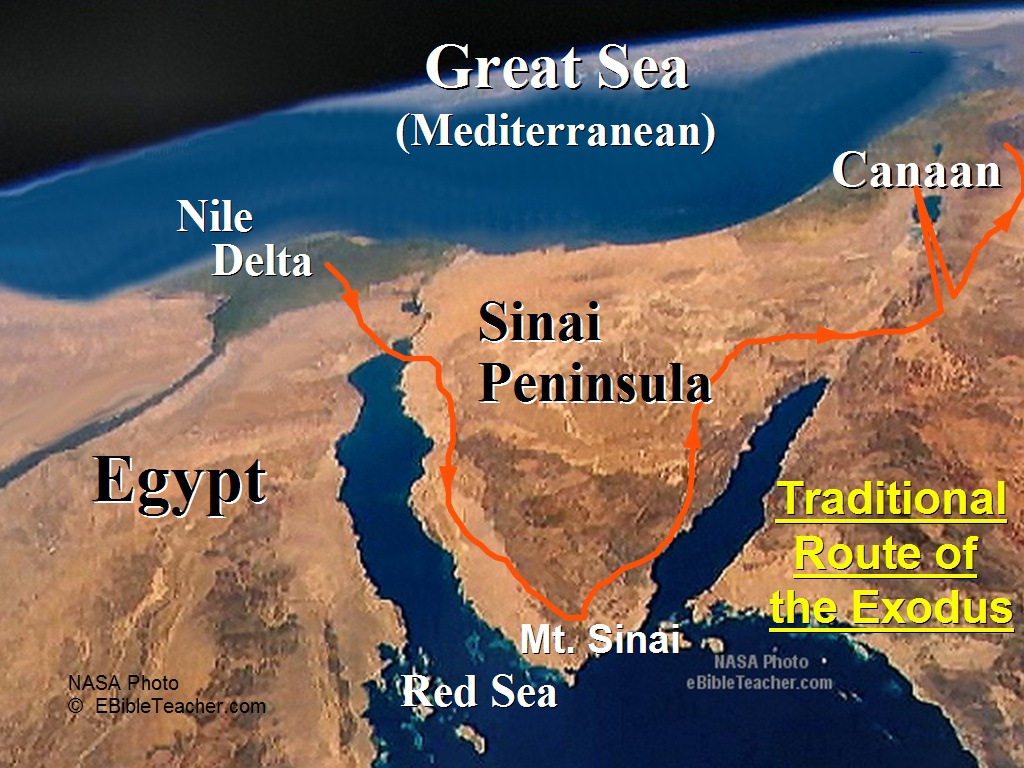 Since leaving Mount Sinai, the Israelites have traveled a few months toward the land of Canaan, or the Promised Land. They’ve arrived at the southern border of the Promised Land and are camped there. Verses 1-3 of chapter 13 indicate that God commands Moses to send out 12 representatives of each tribe of Israel to explore the land before the whole of Israel makes its way into the land.
Since leaving Mount Sinai, the Israelites have traveled a few months toward the land of Canaan, or the Promised Land. They’ve arrived at the southern border of the Promised Land and are camped there. Verses 1-3 of chapter 13 indicate that God commands Moses to send out 12 representatives of each tribe of Israel to explore the land before the whole of Israel makes its way into the land.
We learn in Deut 1, however, that it was the people themselves that requested an exploratory party be sent out, so it seems that God acquiesced to this request rather than initiating it. The very fact that they did not trust God enough to enter the land, sight unseen, is testament to a potential lack of faith.
Verses 4-16 carefully list each of the twelve explorers that Moses sent out. Take note of Caleb son of Jephunneh and Hoshea (Joshua) son of Nun, for their roles will become critical as the narrative unfolds.
In verses 17-20, Moses gives the explorers careful instructions. They are to travel deep into the land and collect information on the condition of the land for agriculture, the strength of the people living there, and the fortification of their cities. They are also to bring back fruit from the land.
We see, in verses 21-25, that they did exactly as Moses commanded. Their journey lasted about 40 days and they likely covered 350 to 500 miles.
The explorers finally return and give their report. They describe the land as very rich for agriculture, but they report that the people are large and powerful, and that the cities are heavily fortified. Caleb, hearing the negativity from the other explorers, steps in and urges the leaders of Israel to go up and take possession of the land, regardless of the strength of the people living there. With God on their side, victory is assured!
The other explorers dissent from Caleb and claim that the people are too strong for Israel, that the Israelites will be devoured by the land. They scare the Israelites by saying that “we seemed like grasshoppers in our own eyes, and we looked the same to them.”
At the end of chapter 13 of Numbers, the Israelites are at a critical juncture. Will they listen to the negative reports of the 10 explorers, or will they trust God to drive out the Canaanites so that they can settle in the land that God promised them? The question is answered immediately in chapter 14.
Verses 1-4, in chapter 14, describe the outright rebellion of the people against God and against his appointed leaders, Moses and Aaron. They lament, once again, that God brought them out of Egypt. They are convinced that they will be killed in Canaan and their children taken as plunder.
R. Dennis Cole comments on the reaction of the Israelites:
The very people who had seen first hand the marvelous and miraculous demonstration of God’s omnipotence against one of the most powerful nations of the second millennium B.C. now longed to return to a world of bondage rather than believe a word of blessing. The sinful human tendency, even among Christians, to lapse back into the addictive ways of sin and despair after having seen the outward demonstration of God’s working on their behalf was evidenced in this setting.
Often in a state of rebellion against God, one loses the benefit of spiritual mooring, whereby wisdom and discernment become elusive and proper decision making is made extremely difficult. Worry and fear dominate one’s thought patterns. The Israelites had thus renounced and rejected God’s beneficence, by now suggesting that a return to Egypt would be a good thing rather than marching into a land that even the cynical scouts deemed as good.
Moses and Aaron fall down before God in submission and in an effort to assuage His anger. Caleb and Joshua try once again to plead with the leaders of Israel to stay the course and take the land, reminding the people of Israel repeatedly that God is with them! The Israelites will have none of it.
As they get ready to stone to death their God-appointed leaders, Moses and Aaron, along with Caleb and Joshua, God unmistakably appears over the tabernacle to intervene. He says to Moses, “How long will these people treat me with contempt? How long will they refuse to believe in me, in spite of all the miraculous signs I have performed among them? I will strike them down with a plague and destroy them, but I will make you into a nation greater and stronger than they.”
Moses then intercedes for Israel, noting that God is “slow to anger, abounding in love and forgiving sin and rebellion.” He reminds God that He has already pardoned the Israelites many times since they left Egypt. But, Moses also knows that God cannot let this rebellion go unpunished. Moses has a profound understanding of God’s nature, which is a balance of mercy and justice. God is not either merciful or just, He is both.
So how will God both show mercy to Israel and yet give them justice after their lack of faith in Him? In verses 20-38, we see the consequences for three different groups of people. For the ten explorers who incited the rebellion with their report, God punished them with a lethal plague. For those adults over the age of twenty at the time of the rebellion, they would never enter the Promised Land; they would die by natural causes in the wilderness over the next 38 years. For the children under twenty years of age, they would be forced to live a nomadic life in the wilderness for 38 years while the adults in their midst died off. Only then could they enter the Promised Land.
In a final sad epilogue (verses 39-45), some of the Israelites determine to ignore God’s sentence on them, and instead take an army to attack the Amalekites and Canaanites, an effort to start taking possession of the Promised Land, the very thing they had just refused to do. Moses warns them that God will not be with them, and, sure enough, they are soundly defeated.
R. Dennis Cole concludes:
Sometimes the consequences of sin and rebellion are irreversible, and one must endure the experience of God’s judgment before a new course of action brings blessing. Sometimes those consequences endure for a lifetime, but even in those settings we must continue in faith so that our lives reflect redemption rather than further reproach.
 Proponents of the various versions of the Documentary Hypothesis believe there must be 4 or more authors of the Pentateuch for several reasons, but the three most common are:
Proponents of the various versions of the Documentary Hypothesis believe there must be 4 or more authors of the Pentateuch for several reasons, but the three most common are: The Israelites are now wandering in the wilderness for 38 years because of their refusal to take possession of the Promised Land. The events of chapters 16 and 17 take place some time during this time period, but the author does not tell us exactly when.
The Israelites are now wandering in the wilderness for 38 years because of their refusal to take possession of the Promised Land. The events of chapters 16 and 17 take place some time during this time period, but the author does not tell us exactly when. While Jews and Christians have traditionally believed that Moses was the primary author of the Pentateuch, some biblical scholars today reject that belief. Instead, these scholars believe that the Pentateuch was written over several centuries by several different authors and not finally compiled into its final form until just a few hundred years before Jesus was born.
While Jews and Christians have traditionally believed that Moses was the primary author of the Pentateuch, some biblical scholars today reject that belief. Instead, these scholars believe that the Pentateuch was written over several centuries by several different authors and not finally compiled into its final form until just a few hundred years before Jesus was born. Since leaving Mount Sinai, the Israelites have traveled a few months toward the land of Canaan, or the Promised Land. They’ve arrived at the southern border of the Promised Land and are camped there. Verses 1-3 of chapter 13 indicate that God commands Moses to send out 12 representatives of each tribe of Israel to explore the land before the whole of Israel makes its way into the land.
Since leaving Mount Sinai, the Israelites have traveled a few months toward the land of Canaan, or the Promised Land. They’ve arrived at the southern border of the Promised Land and are camped there. Verses 1-3 of chapter 13 indicate that God commands Moses to send out 12 representatives of each tribe of Israel to explore the land before the whole of Israel makes its way into the land. The Bible describes the place-names and geography of the route that Israel took from Egypt to the plains of Moab, across from the city of Jericho, during the 40 years in the wilderness. So why is it that archaeologists and biblical scholars cannot agree on the exact route that was taken?
The Bible describes the place-names and geography of the route that Israel took from Egypt to the plains of Moab, across from the city of Jericho, during the 40 years in the wilderness. So why is it that archaeologists and biblical scholars cannot agree on the exact route that was taken? As we pick up in chapter 9 of Numbers, Moses reminds the reader of the presence of God in the cloud above the tabernacle. On the first day the tabernacle was completed (first day of the second year of the exodus, or 1445 BC), the cloud covered it (recall Exodus 40:34). Verses 15-23 in chapter 9 explain what the cloud meant for the Israelites.
As we pick up in chapter 9 of Numbers, Moses reminds the reader of the presence of God in the cloud above the tabernacle. On the first day the tabernacle was completed (first day of the second year of the exodus, or 1445 BC), the cloud covered it (recall Exodus 40:34). Verses 15-23 in chapter 9 explain what the cloud meant for the Israelites. Now this is an interesting question. Randy Alcorn says “yes” in his book
Now this is an interesting question. Randy Alcorn says “yes” in his book  In chapter 23 of Leviticus, God summons the Israelites to worship and to celebrate seven annual feasts he has appointed. Walter Kaiser and Duane Garrett, in the
In chapter 23 of Leviticus, God summons the Israelites to worship and to celebrate seven annual feasts he has appointed. Walter Kaiser and Duane Garrett, in the